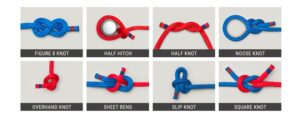In the world of knot tying, mastering the pitchfork knot is both practical and rewarding. Whether you’re an outdoor enthusiast, a scout, or just someone interested in learning new skills, understanding how to tie this knot can be incredibly useful. The pitchfork knot is known for its versatility and strength, making it ideal for various tasks from securing tents to organizing ropes efficiently.
To begin learning the pitchfork knot, it’s essential to grasp its basic structure and functionality. This knot resembles a pitchfork in appearance, hence its name. It’s primarily used for creating a secure loop that can withstand tension without slipping, making it suitable for tasks requiring stability and reliability.
What is the Pitchfork Knot?
The pitchfork knot is a versatile knot used for securing items together. It gets its name because it resembles the prongs of a pitchfork. This knot is known for its strength and reliability in various situations where a secure loop is needed. Learning to tie the pitchfork knot can be useful for activities like camping, boating, or even everyday tasks around the house.
To tie a pitchfork knot, you start by creating a loop with the rope. Then, you wrap the working end around the standing part of the rope several times before feeding it through the loop and tightening it securely. This creates a knot that holds tight under tension, making it ideal for situations where you need something secure but easy to untie when necessary.
Using the pitchfork knot requires practice to get it right. Beginners might find it tricky at first, but with patience and persistence, mastering this knot can become a valuable skill. Once you understand its mechanics, you can apply it in various practical scenarios, from tying down a tarp to organizing your gear efficiently.
History and Origins of the Pitchfork Knot
The history of the pitchfork knot traces back to traditional knot tying techniques used by sailors and outdoorsmen. Its origin lies in the need for a knot that could hold fast under pressure without slipping. Over time, different variations of the pitchfork knot emerged, each adapted to specific uses and materials available.
Early sailors used the pitchfork knot aboard ships to secure sails and rigging, ensuring everything stayed in place even during rough seas. Its reliability made it a staple in maritime knotting, eventually spreading to land-based applications as well. Today, the pitchfork knot remains popular among outdoor enthusiasts and survivalists for its simplicity and effectiveness.
Learning about the origins of the pitchfork knot can deepen your appreciation for its practicality and enduring usefulness. By understanding where it came from and how it evolved, you gain insights into why it’s still relevant in modern knot tying practices. Exploring its history also connects you to a tradition of craftsmanship and practical skills passed down through generations.
Step-by-Step Guide to Tying the Pitchfork Knot
Tying a pitchfork knot involves a series of straightforward steps that anyone can learn with a bit of practice. Begin by forming a loop with the rope, ensuring the working end crosses over the standing part. Then, wrap the working end around the standing part several times, creating a series of coils that resemble the prongs of a pitchfork.
Next, take the working end and feed it through the loop you created earlier. Pull the working end gently while holding the standing part firm to tighten the knot securely. Adjust the loops and coils as needed to ensure the pitchfork knot holds tight without slipping. Practice tying and untying the knot until you can do it confidently and quickly when needed.
Mastering the pitchfork knot involves understanding its structure and how each wrap contributes to its stability. The more you practice, the more familiar you’ll become with its nuances and applications. Whether you’re using it for outdoor activities or practical tasks at home, the pitchfork knot offers a reliable solution for securing items together safely and efficiently.
Practical Uses of the Pitchfork Knot
The pitchfork knot finds practical use in various everyday and outdoor scenarios. Its ability to secure items tightly makes it ideal for tasks such as tying down tarps during camping trips or securing bundles of firewood for transport. This knot’s versatility extends to organizing ropes in storage or creating makeshift handles for carrying objects. Learning its practical uses can enhance your efficiency in managing tasks both at home and in outdoor settings
Why Every Outdoor Enthusiast Should Learn the Pitchfork Knot
For outdoor enthusiasts, mastering the pitchfork knot is essential for safety and convenience. This knot offers a reliable way to secure equipment like tents and backpacks, ensuring they remain stable in windy conditions or uneven terrain. Its simplicity makes it accessible to beginners, while its strength and security make it indispensable for seasoned adventurers. Adding the pitchfork knot to your skill set enhances your preparedness and enjoyment during outdoor adventures, making it a must-learn for anyone who loves exploring nature
Tips and Tricks for Mastering the Pitchfork Knot
Mastering requires attention to detail and practice. Start by practicing with thicker ropes or cords to get a feel for how the knot forms and tightens. Remember to keep the coils of the knot neat and evenly spaced to ensure maximum strength. When tying the pitchfork knot, maintain tension throughout the process to prevent it from slipping. Over time, you’ll develop a knack for tying it quickly and efficiently, making it a go-to knot for various tasks
Common Mistakes Beginners Make with the Pitchfork Knot
Beginners often encounter challenges when learning to tie the pitchfork knot. One common mistake is not wrapping the working end around the standing part enough times, which can result in a loose knot that doesn’t hold securely. Another mistake is pulling the working end too tightly before completing the knot, making it difficult to adjust and tighten properly. Avoiding these mistakes involves practicing the knot slowly and methodically until you understand its mechanics and can tie it confidently in various situations.
Variations of the Pitchfork Knot: Beyond the Basics
Beyond its basic form, the pitchfork knot has several variations that cater to specific needs and preferences. One variation includes adding extra wraps around the standing part to increase the knot’s grip and strength. Another variation involves using different types of ropes or cords, which can affect how the knot tightens and holds under pressure. Exploring these variations allows you to adapt to different tasks and environments, enhancing its versatility and usefulness in your daily activities
When to Use the Pitchfork Knot vs. Other Knots
Knowing when to use the pitchfork knot versus other knots depends on the specific requirements of your task. Use when you need a secure loop that can withstand tension without slipping, such as tying down heavy loads or securing objects in place. Other knots, like the square knot or clove hitch, may be more suitable for different purposes, such as joining two ropes together or securing a temporary line. Understanding the strengths and limitations of each knot helps you choose the right one for each situation, ensuring efficiency and safety in your knot tying endeavors
Fun Facts About the Pitchfork Knot You Didn’t Know
The pitchfork knot has an interesting history and unique characteristics that make it stand out among other knots. For example, its name comes from its resemblance to the prongs of a pitchfork, reflecting its original use in agricultural settings. Over time, this knot evolved to become a staple in maritime and outdoor activities, demonstrating its versatility and reliability. Learning these fun facts adds depth to your understanding and its role in practical knot tying practices
Safety Precautions When Using the Pitchfork Knot
Using the safely involves understanding its limitations and applying it appropriately to each task. Always inspect the knot before relying on it to ensure it’s tied correctly and securely. Avoid overloading the knot beyond its recommended capacity to prevent it from slipping or breaking under pressure. When untying the pitchfork knot, do so carefully to avoid sudden releases of tension that could cause injury. By practicing proper safety precautions, you can use the effectively and safely in various situations
Exploring Advanced Applications of the Pitchfork Knot
Beyond its basic uses, the pitchfork knot has advanced applications that require precision and skill. These include creating decorative knots for crafts or designing intricate patterns using multiple in a sequence. Advanced users may also use in specialized fields such as rock climbing or sailing, where its strength and reliability are crucial for safety and performance. Exploring these advanced applications expands your knot tying abilities and opens up new possibilities for using the creatively and effectively.
What Makes the Pitchfork Knot Unique?
The pitchfork knot stands out among other knots due to its distinctive appearance and practical applications. Its design resembles the tines of a pitchfork, making it easy to recognize and remember. This knot’s uniqueness lies in its ability to create a secure loop that holds firm under tension, making it valuable for tasks requiring stability and reliability. Understanding what makes the unique helps you appreciate its versatility and usefulness in various situations, from outdoor adventures to everyday tasks
Mastering the Pitchfork Knot: Practice Makes Perfect
Mastering the pitchfork knot requires patience and practice. Begin by practicing with different types of ropes or cords to understand how each material affects the knot’s grip and strength. Focus on maintaining even tension throughout the tying process to ensure the holds securely. As you gain experience, challenge yourself with more complex variations of the knot to enhance your skills. With consistent practice, you’ll become proficient in tying the quickly and confidently whenever you need to secure items safely and effectively.
Benefits of Learning the Pitchfork Knot
Learning the pitchfork knot offers numerous benefits for both practical and recreational purposes. This knot provides a reliable way to secure equipment during outdoor activities such as camping, hiking, or boating, ensuring your gear stays in place even in challenging conditions. Its simplicity makes it accessible to beginners, while its strength and versatility make it indispensable for experienced adventurers. By learning the pitchfork knot, you enhance your ability to handle various tasks efficiently and safely, making it a valuable skill for anyone who enjoys outdoor adventures or practical DIY projects.
The Pitchfork Knot in Survival Situations
In survival situations, the pitchfork knot serves as a crucial tool for securing shelters, creating makeshift tools, or organizing supplies. Its ability to withstand tension without slipping makes it invaluable for constructing shelters using natural materials like branches or vines. Knowing how to tie can mean the difference between comfort and discomfort in challenging environments. By including in your survival skillset, you enhance your ability to adapt and thrive in unpredictable situations, making it a must-learn knot for outdoor enthusiasts and adventurers alike.
Teaching Kids the Pitchfork Knot: Fun and Educational
Teaching kids how to tie the pitchfork knot is a fun and educational activity that promotes coordination and problem-solving skills. Start by demonstrating the basic steps using larger ropes or cords that are easier for small hands to manipulate. Encourage kids to practice tying the knot themselves, offering guidance and support as needed. As they gain confidence, challenge them with different variations of the to keep them engaged and excited about learning new skills. Teaching kids the not only prepares them for outdoor adventures but also fosters a sense of independence and accomplishment.
Knot Tying Competitions: Mastering the Pitchfork Knot
Participating in knot tying competitions showcases your mastery of knots like the pitchfork knot among peers and enthusiasts. These competitions challenge participants to tie knots quickly and accurately under pressure, testing their skills and knowledge. Mastering allows you to compete confidently, demonstrating your ability to tie this knot efficiently and securely. Whether you’re competing for fun or recognition, knot tying competitions offer a platform to showcase your expertise and passion for practical knot tying techniques.
Integrating the Pitchfork Knot into Crafts and DIY Projects
The pitchfork knot isn’t just for practical use; it also lends itself well to crafts and DIY projects. Incorporate this knot into macramé designs, bracelet making, or decorative rope art to add texture and visual interest. Experiment with different materials and colors to create unique patterns and combinations using. Its versatility allows you to explore your creativity while mastering essential knot tying skills. By integrating into crafts and DIY projects, you elevate your creations with a touch of practicality and craftsmanship.
The Pitchfork Knot: A Symbol of Tradition and Innovation
Throughout history, the pitchfork knot has symbolized both tradition and innovation in knot tying techniques. Its origins in maritime and agricultural settings reflect its practicality and durability in everyday tasks. Over time, advancements in materials and techniques have expanded the applications, making it relevant in modern outdoor activities and DIY projects. Embracing the honors its legacy while embracing innovation to meet contemporary needs and challenges. By learning and mastering this knot, you contribute to its ongoing evolution and ensure its legacy continues for future generations.
Conclusion: Master the Pitchfork Knot Today!
Now that you’ve explored the world of the pitchfork knot, you’re equipped with essential skills for various tasks, from camping adventures to everyday challenges at home. Remember, mastering The takes practice and patience, but it’s worth the effort. With its strong hold and versatility, this knot becomes your go-to solution for securing gear, organizing ropes, and even creating crafts. Whether you’re a beginner or an experienced knot-tier, The offers something valuable for everyone to learn and enjoy. So, grab some rope, follow the steps, and start mastering the pitchfork knot today!
By understanding the history, practical uses, and unique features you’ve unlocked a skill that combines tradition with modern application. Its simple yet effective design ensures reliability in various situations, making it a favorite among outdoor enthusiasts and DIY enthusiasts alike. As you continue to practice and explore its possibilities, you’ll discover new ways to incorporate into your daily life, adding a touch of craftsmanship and practicality to everything you do. So, keep tying, keep learning, and embrace the versatility in your adventures and projects!







